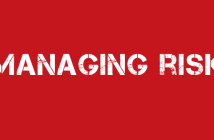I was once deposed for a case involving a fatality at a ski area. Many of the questions were about the sort of things you’d expect—signage, warnings, snow conditions.
Then, the plaintiff’s attorney produced a poster, and introduced it into evidence. It was extremely simple, created by the resort’s art director. The caption said, “Before you ski Shock Wave, White Heat, or Vortex, make sure you bring the proper equipment.” Those are the names of three steep, expert-only trails. The image was of two metallic spheres, notably yellowish-brown in color.
Now, this was more than 20 years ago, when the ski industry was nearly choking on its own testosterone. You couldn’t possibly get away with a poster like that today. Back then, though, it was our top seller.
I was astonished to see it. I was even more astonished when the plaintiff’s attorney started grilling me about it—especially his suggestion that the resort was essentially daring people to ski trails beyond their ability. “Brass BALLS?” he thundered. “Explain to me why that’s not enticing people. In fact, that’s not enticing them—that’s inciting them. And my client is a widow as a result!”
The case settled before I faced that line of questioning in court. But if a lawyer could attempt to make hay out of an innocuous—if tasteless—poster, imagine what one could do with an actual broken promise, such as a promise of safety.
Risk Is Inherent
In the experiential education world, challenge courses, zip lines, and other aerial elements are meant to intimidate and create the perception of risk. Properly managed, that risk is small—but in that setting, facing and accepting risk is a core purpose of the learning experience. Also: safety is presented as a shared responsibility of all participants. That, too, is a core purpose.
But the mindset of someone signing up for Outward Bound is different from that of someone getting off a cruise ship to ride a zip line. Those vacationers are more likely to perceive the experience as a thrill ride than as a learning experience. They’re there for fun, and they expect it to be safe.
Are you—by means of your brochures, website, and other outreach mechanisms—promising them that it is? That’s a promise you can’t afford to make.
Perhaps you think that your liability release covers the situation. It might not. Some states, such as New York, essentially hold that liability releases related to risky activities are worthless. The Supreme Court in Oregon recently opined that liability releases that effectively present the customer with a choice between signing or not participating in the activity are “unconscionable.”
Regardless, if a screen grab of your website implies safety in so many words, it’s easy for plaintiff’s counsel to compare it with a densely-written release suggesting otherwise.
You can’t guarantee anyone’s safety.
Aerial elements will always present some degree of risk. Gravity is ever present. Continuous belay systems are a huge improvement over, say, old-style dual-lead pelican hooks, but a guest who’s sufficiently determined can probably figure out how to trick those systems and come off belay. Each time we humans think we’ve made something foolproof, Mother Nature accepts the challenge and develops a better fool.
Then there are environmental factors, such as unexpected high winds. And your best-trained, most conscientious employee could still have a moment of inattention that produces a bad result.
Choose Your Words Wisely
So what should you do? Start by carefully examining all of your promotional materials, online and otherwise. Look for language that implies a promise of safety. A statement along the lines of, “You’ll have a safe, fun experience!” is asking for it. A statement that your staff undergoes twenty hours of safety training each season is better, provided that you’ve got the systems—and records—to back it up.
It’s fine to say that all of your equipment is inspected daily—assuming you actually do so. But don’t back that claim with subjective blather such as “to ensure your safety and flawless performance!” Gear can break regardless of inspection.
Personally, I think it’s best to be up front with your guests about the risks. Consider including an easy-to-find section of your website that specifically discusses risk factors and how you manage them—but also makes clear that participation still involves risk, however small.
Extend that concept to your print materials, onsite signage, and any other means you use to communicate with the public. And make certain you create a culture of safety within your staff, from the first moment of their first training session.
It’s a good idea to run all promotional materials by liability and/or risk-oriented legal counsel prior to publishing, either online or print. Alternatively, you might ask your liability underwriter to review your materials to ensure there aren’t problems with it. Remember, they’ve got skin in the game, too.
Nobody wants a premises accident, and responsible operators do everything possible to minimize the likelihood. That’s great. But don’t be so proud of your efforts that you inadvertently make matters worse by bragging about it.




